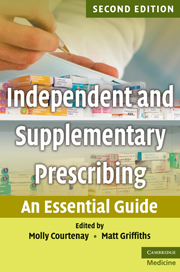Book contents
- Frontmatter
- Contents
- List of contributors
- Foreword to the second edition
- Preface to the second edition
- 1 Non-medical prescribing: an overview
- 2 Non-medical prescribing in a multidisciplinary team context
- 3 Consultation skills and decision making
- 4 Legal aspects of independent and supplementary prescribing
- 5 Ethical issues in independent and supplementary prescribing
- 6 Psychology and sociology of prescribing
- 7 Applied pharmacology
- 8 Monitoring skills
- 9 Promoting concordance in prescribing interactions
- 10 Evidence-based prescribing
- 11 Extended/supplementary prescribing: a public health perspective
- 12 Calculation skills
- 13 Prescribing in practice: how it works
- 14 Minimising the risk of prescribing error
- Index
- References
3 - Consultation skills and decision making
Published online by Cambridge University Press: 10 January 2011
- Frontmatter
- Contents
- List of contributors
- Foreword to the second edition
- Preface to the second edition
- 1 Non-medical prescribing: an overview
- 2 Non-medical prescribing in a multidisciplinary team context
- 3 Consultation skills and decision making
- 4 Legal aspects of independent and supplementary prescribing
- 5 Ethical issues in independent and supplementary prescribing
- 6 Psychology and sociology of prescribing
- 7 Applied pharmacology
- 8 Monitoring skills
- 9 Promoting concordance in prescribing interactions
- 10 Evidence-based prescribing
- 11 Extended/supplementary prescribing: a public health perspective
- 12 Calculation skills
- 13 Prescribing in practice: how it works
- 14 Minimising the risk of prescribing error
- Index
- References
Summary
Much of the research on the consultation has developed from the desire of general practice to carve out for itself a specific body of expertise distinct from hospital medicine (Drucquer and Hutchinson 2000). As a result, while there is a considerable amount of literature relating to general practice, as practised by the general practitioner (GP), little has been written on consultations by other health professionals, and little on consultations in secondary care. This chapter will endeavour to introduce to the reader some of the key texts on consultation models and communication skills, and discuss their relevance for non-medical prescribers. Patients' health beliefs will be briefly explored, as will the literature comparing the outcomes of consultations by doctors and other health professionals. Decision-making strategies and diagnosis will be looked at, with a brief overview of computer decision support in the consultation. A chapter such as this can only hope to give a brief synopsis of these issues, and it is hoped that the reader will use the reference list to follow-up areas of particular interest in more detail.
Consultation models
The concept of nurses and other healthcare professionals (HCPs) undertaking a consultation is relatively new. While the consultation will for many prescribers form the basis of the interaction during which they prescribe, for others, this will be less clear… consider ward-based practitioners and those working in the patient's home. However, for practitioners working in all of these settings, many of the concepts discussed will be of relevance.
- Type
- Chapter
- Information
- Independent and Supplementary PrescribingAn Essential Guide, pp. 15 - 28Publisher: Cambridge University PressPrint publication year: 2010



